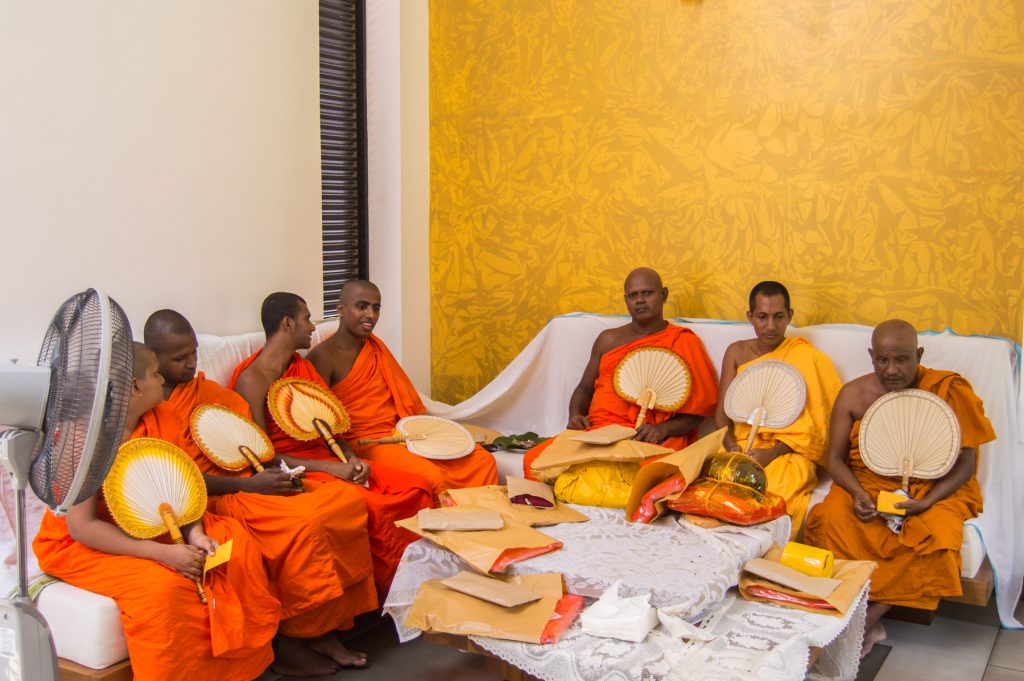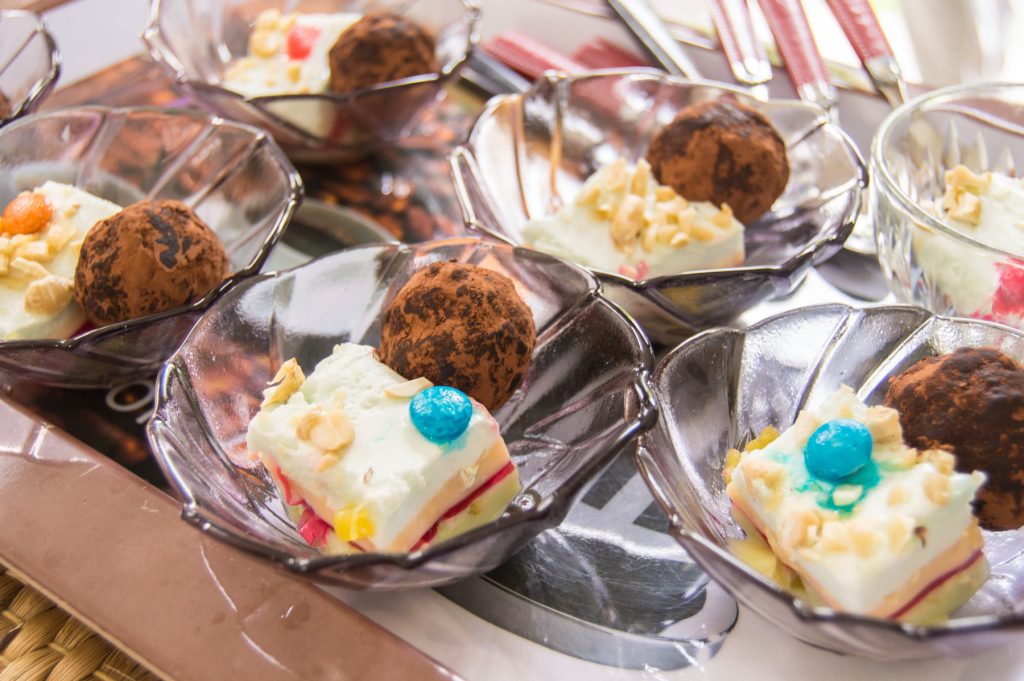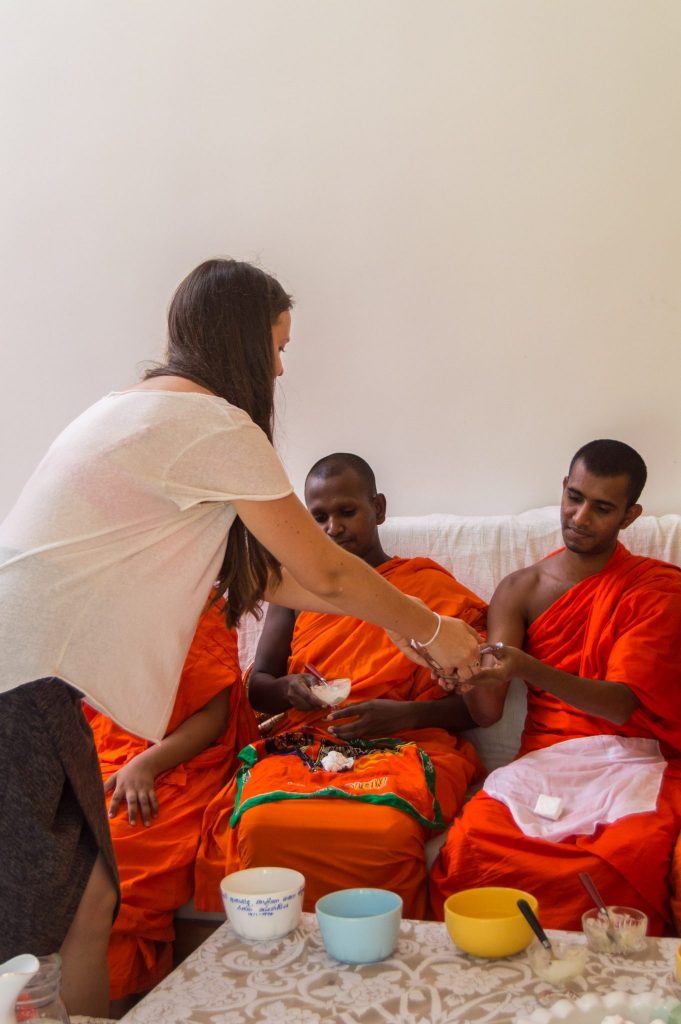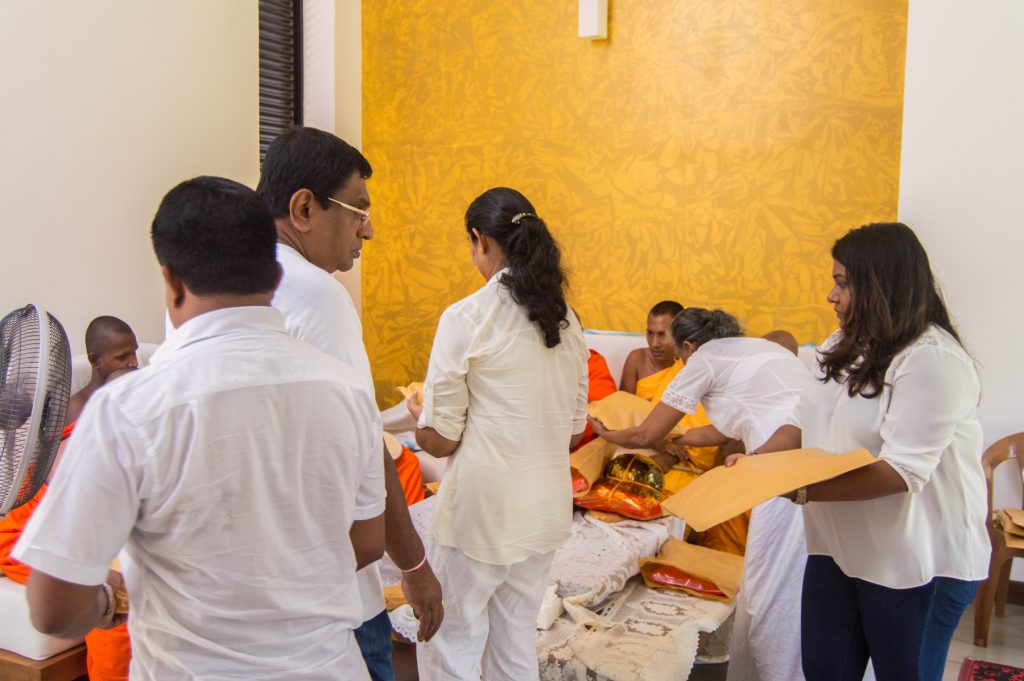The house before dana was a mess. Don’t take me wrong: physically, it was clean and shiny. The floors had been scraped so hard you could almost see your own reflection. The furniture had been moved to create more room. New beautiful tableware replaced everyday plates and cups. The mood, though, was somewhere on the crossroads of a big Christmas party and the most important exam in one’s life. I felt exited and cheerful, but at the same time, anxious, stressed out, and a little too eager for all of it to end.

The living room prepared for dana: the couch is covered with white sheets, the table – with white tablecloth.
If this was my range of emotions, then my parents-in-law who were throwing the dana – I am not sure what you do with dana, let’s assume you throw it like a party – must have been on the verge of exploding.
But let’s rewind a few months back, to the time I was planning a trip to my husband’s homeland of Sri Lanka. That’s when, during a Skype conversation with his parents, the word dana came up for the first time. My parents-in-law had built a new house and were planning to gather the whole family for pirith and dana, two traditional Buddhist ceremonies.
Having lived in Sri Lanka for three years, I wasn’t surprised that such a life-changing event as moving into a new house would be followed by traditional ceremonies. After all, I had witnessed boiling milk in the middle of the night during New Year celebrations and breaking a coconut at my own wedding. Monks coming to a new house to give their blessings was expected.
The only thing I didn’t expect was the scale of dana. What I thought would be a small family gathering turned into an event that required hiring a catering company and renting chairs, because in addition to 7 monks, 70 guests were invited. My bad, though. I should have anticipated this. Given that between 300 and 600 guests are usually invited to a Sri Lankan wedding, 70 guests for a housewarming seems just about right.
How big pirith and dana are going to be every family decides for itself. My parents-in-law chose to invite all our relatives, friends, and neighbors for dana, but have a small pirith ceremony the night before with only immediate family members.
Pirith, the Ceremony of Protective Chanting
The preparations for pirith and dana start long in advance with booking monks for the event. Don’t Buddhist monks sound like rock stars? One has to visit a temple two or three months in advance to make arrangements.
On the night before dana, three monks arrived at our house for pirith, a ceremony that goes hand in hand with any big event in the life of Sri Lankan Buddhists, be it moving into a new house, wedding, or birth of a child.

Pirith describes both the ceremony and the set of protective chants recited by monks during the said ceremony. The term is derived from Pali word “paritta” which means “protection”. Ceremonial recital of pirith helps ward off all forms of evil and bring good luck.
In preparations for pirith the couch and the table in the living room were covered with white sheets. A jug of water, a Buddha statue, a bowl with flowers, and burning incenses placed on the table.

The monks sat down on the couch; the family members in front of them on the floor. The ceremony was not unfamiliar to me since I’d taken part in pirith three years ago, before my wedding. I knew I was up for one uncomfortable hour of shifting weight from side to side, trying to quietly stretch my legs, then pull them back under me while the monks were chanting, looking completely undisturbed.

Tray with betel leaves, arecanut, cardamoms, and nutmeg served to the monks as an invitation to start the ceremony of pirith
Pirith began by welcoming the monks and offering them a tray with betel leaves, arecanut, cardamoms, and nutmeg, which is regarded as an invitation to start the ceremony. Next, one of the monks took a thread, twisted it around a jug of water, and passed it to the other monks and all the family members. Once we were all connected by a single thread, the chanting commenced.
The verses monks chant during pirit are texts written in Pali – a language used during the times when Buddha was alive – and collected in the book of parritas, or pirith-pota. Among Buddhists in Sri Lanka pirith-pota is one of the most well-known Pali books which is held in honor and respect even by those who are not educated.
Since Pali is not used in the modern world, I was, in fact, not the only one in the room who could not understand what the monks were chanting. My family was just as clueless. In the end of the ceremony the monks switched to Sinhalese – the official language of Sri Lanka – which made things easier. That is for my family, not for me.
During the ceremony, the jug with water and the thread become sanctified through the chanting and are used afterwards as a protection against evil. Each of us took a sip of water. The thread was cut into parts and tied by the chief monk around the wrist of each family member.
Making Kartoshka, Classic Soviet Treat, for Sri Lankan Monks
Once the monks were taken back to the temple, the house turned into a beehive. The time was close to midnight. Preparing to host 70 guests expected for dana the next morning was no joke.
The female part of the family rushed back to the kitchen. Since dana essentially means “giving”, a big feast was being prepared to feed the monks. Somewhere between peeling onions for seeni sambol and dipping fish balls into boiling oil, my mother-in-law suggested that I should cook something Russian. Monks visit houses for dana fairly often and get served the same Sri Lankan rice and curry. Wouldn’t it be fun to offer them something different?
As excited as I was to cook for Buddhist monks, the short amount of time I had and the fear of screwing it up and forever destroying my own reputation and that of Russian cuisine, forced me to choose the easiest recipe – Soviet kartoshka.

Midnight. 100 degrees Fahrenheit. No AC. Me making a classic Soviet dessert for Buddhist monks. Surreal.
Named after potato because of its looks, kartoshka used to be a way for Soviet cooks to utilize cake leftovers. A simple dessert that was born out of desire to save a few pennies turned into a beloved Soviet classic. Nowadays, cookie crumbs are used instead of cake leftovers. They are mixed with butter, condensed milk and cocoa powder, then shaped into balls.

The thread on my right hand is the thread used for pirit ceremony that the chief monk cut into pieces and tied around each family member’s wrist.
With the help of my father who insisted that I add more, and a little more, and then some more melted butter into the mixture, I successfully screwed the first batch of seemingly unscrewable kartoshka. We saved it by adding more cookie crumbs, but my hands, shiny with butter, on the picture above are clear evidence that something went wrong. I went to sleep close to one in the morning leaving my mother-in-law and the helper to finish the preparations.
Dana, the Ceremony of Giving Alms to the Monks
The house before dana was a mess. The chairs arrived late, were the wrong type, and had to be replaced after some arguing. The caterers were still in the process of setting up tables when the first guests showed up. The adapters didn’t fit the plugs causing fans to stop working. The guests tried to be helpful but kept running into each other and stumbling over dozens of chairs. Meanwhile, the kids played around an artificial pond in the dining room, occasionally trying to take a dip or at least pick the fishes out of it.
Dana often follows the ceremony of pirith on important occasions like house-warming, birth of children, or wedding, but can be organized on its own, too. The full Sinhalese name, sanghika-dana, means “the alms given to the community of monks.” Simply explained, it is an act of offering food and presents to monks.
The beginning of dana is very similar to pirith ceremony. The monks are conducted from the temple by one of the family members. At the entrance they are greeted by the host. As the monks step into the house, one person washes their feet and another wipes them.

My father-in-law carrying the relic casket on his head in the procession of monks
With them, monks bring a relic casket containing a bone relic of the Buddha. The casket is borne on the head of the layman in the beginning of the procession and later set on a separate table in the house. The casket is part of the Buddhist trinity and represents Lord Buddha.

Seven monks arrived at our house at eleven in the morning, proceeded into the living room and sat on the couch. Dozens of guests dressed in white sat on the floor in front of them, and all of a sudden the house turned quiet.

The chief monk began the ceremony by doing a short chanting session after which almsgiving started. Alms were first offered to the Buddha by placing a plate of rice and curry on the table with relic casket.

Rice and curry prepared for alms giving
Next, the food was offered to the monks in order of seniority. The monks cannot ask for food or serve it themselves, which is why there were always people at the table ready to serve them. Since serving monks is considered an honor, guests were taking turns, so everyone could participate.

Jello cake and my kartoshka cookies waiting to be served to the monks
Rice and curry were followed by dessert of which we had four: fruits, traditional Sri Lankan curd with kithul treacle, layered jello cake and my humble kartoshka. The truth is, although several types of desserts are always prepared for dana, monks almost always refuse to have them. Which I learned approximately five minutes before I headed to the monks with a tray of desserts in my trembling hands. “I am scared!” I whispered to my Sri Lankan friend who cheerfully replied with: “It’s ok! They will probably not eat it anyways!” Thanks, that helps!


My mother-in-law explained to the monks in Sinhalese that one of the desserts was a traditional Russian treat specially prepared by me. I held out a small plate to the chief monk expecting him to refuse it, but, to my surprise, he accepted and so did the rest of the monks.
After lunch they received other offerings, the most important of which ata-prikara – “the eight monastic requisites” – consisted of three robes, a belt, a razor, a water-strainer, a sewing needle, and an alms-bowl. Ata-pirikara was offered to the chief monk, while others received books and robes.

Guests offering presents to the monks
The monks were conducted back to the temple in the same manner as they were brought. My father-in-law, as a layman, carried the casket relic on his head in the end of procession covered by umbrella.

The monks are conducted into a car to take them back to the temple. My father-in-law is carrying casket relic on his head in the end of procession.
When the car with monks left, I could almost hear a communal sigh of relief. The house was blessed and good for living. People stopped running around, divided into smaller groups and sat down to finally eat rice and curry. My closest friends and I took over the couch where only a few minutes ago the monks were chanting and accepting offerings.

Curd (local yogurt) and kithul treacle (natural sweet syrup) served to monks were politely declined
As lunch was coming to an end, I looked at the aftermath of dana. The tray with seven plates of desserts was still on the table. Half of kartoshka was gone, another half was bitten into. I wasn’t sure whether it was the curiosity to try Russian cuisine or the monks simply took pity on a Russian girl who clearly didn’t understand a word during the ceremony. Either way, Sri Lankan Buddhist monks ate Soviet treats which I consider both surreal and awesome. The curd with treacle served afterwards was left untouched.
Special thank you to my family in Sri Lanka who let me be a part of the ceremonies and explained every step of the way to me. The article “Buddhist Ceremonies and Rituals of Sri Lanka” by A.G.S. Kariyawasam was very helpful in writing this post.
Pin for later:





Very, very cool. Thank you so much for sharing this. I’m always interested to learn more about how different cultures celebrate rights of passage or significant life events.
Thank you for the kind words, Terra! I am happy to share traditions and customs of my beloved Sri Lanka!